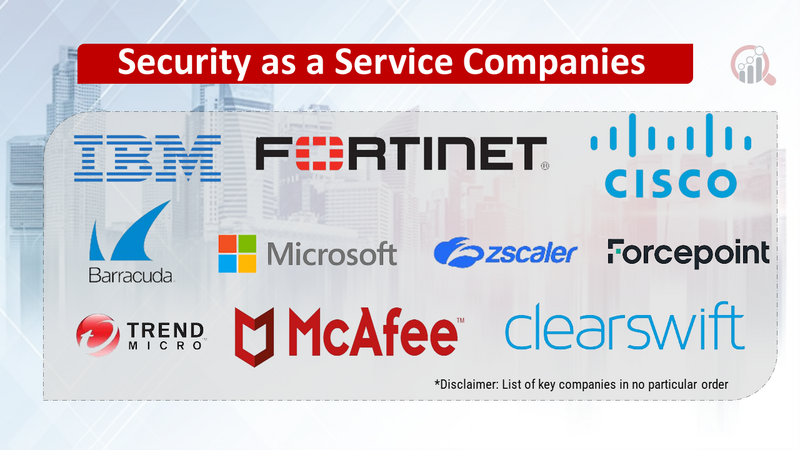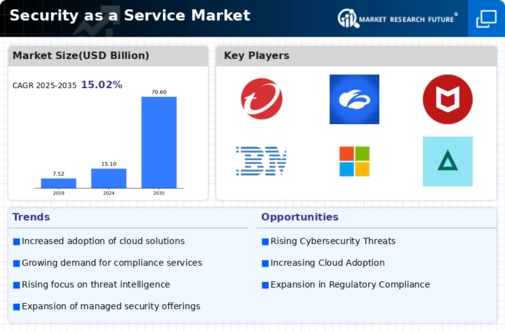Top Industry Leaders in the Security as a Service Market

Security as a Service Market: Dive into the Latest News and Updates
In today's hyper-connected world, cybersecurity concerns no longer lurk in the shadows. Breaches, malware, and cyberattacks dominate headlines, reminding businesses that securing their digital ecosystem is paramount. Enter Security as a Service (SECaaS), a knight in shining armor, offering an agile and cost-effective way to bolster defenses without the burden of in-house security infrastructure.
Some of Security as a Service Companies Listed Below:
- Trend Micro (Japan)
- Zscaler (US)
- McAfee (US)
- IBM (US)
- Microsoft (US)
- Clearswift (UK)
- Alert Logic (US)
- Forcepoint (US)
- Sophos (UK)
- Barracuda Networks (US)
- Cygilant (US)
- Cisco (US)
- Fortinet (US)
- Panda Security (Spain)
- Radware (China)
- Mindsight (US)
Strategies Fueling Growth:
-
Hybrid and Multi-Cloud Support: Offering SECaaS solutions that seamlessly integrate across diverse cloud platforms and on-premises environments allows businesses to manage security consistently regardless of infrastructure. -
Zero-Trust Network Access (ZTNA) Adoption: Providing ZTNA functionalities within SECaaS offerings enhances security by granting least-privilege access, minimizing attack surfaces, and improving data protection. -
Security Automation and Orchestration (SOAR): Integrating tools for automated incident response, security workflow management, and threat remediation simplifies security operations and reduces human error. -
Threat Intelligence and Advanced Analytics: Utilizing real-time threat intelligence feeds, machine learning algorithms, and AI-powered analytics empowers businesses to proactively identify and mitigate security risks.
Market Share Decoding: Key Factors to Consider:
-
Functionality and Feature Set: Platforms offering a comprehensive range of security tools, including endpoint protection, network security, cloud security, and threat intelligence, cater to diverse security needs and complexities. -
Deployment Flexibility: Ability to deploy SECaaS solutions on-premises, in the cloud, or in hybrid environments ensures flexibility and caters to businesses with existing infrastructure investments. -
Scalability and Performance: SecaaS platforms must handle large volumes of data, process security events efficiently, and scale with business growth to handle evolving security demands. -
Pricing and Cost-Effectiveness: Flexible pricing models, pay-as-you-go options, and tiered subscription plans make SECaaS accessible to businesses of all sizes and budgets.
New and Emerging Stars: Illuminating the SECaaS Path
-
Cybersecurity Mesh Architecture: Startups like Lacework and Palo Alto Networks explore cybersecurity mesh architectures for distributed security solutions, enabling flexible and resilient defense across diverse environments. -
Cloud-Native Security Platforms: Companies like Netskope and Zscaler develop cloud-based security platforms that integrate seamlessly with cloud deployments, offering comprehensive protection without the burden of on-premises hardware. -
AI-Powered Security Analytics and Threat Detection: Startups like Darktrace and Deepwatch utilize AI and machine learning to analyze security data, identify anomalous behavior, and predict potential threats, enhancing proactive security efforts.
Latest Company Updates:
November 17, 2023:
-
Microsoft Defender for Cloud expands security capabilities: This platform now offers extended threat detection and response (XDR) features for comprehensive cloud security across multiple vendors.
December 8, 2023:
-
Palo Alto Networks announces integration of Cortex XDR with MDR service: This combination provides managed detection and response (MDR) services powered by AI-driven XDR technology, enhancing threat detection and incident response. -
Ransomware attacks continue to surge: According to reports, ransomware attacks increased by 38% year-over-year, highlighting the critical need for robust security solutions.
January 6, 2024:
-
Focus on zero-trust security architectures: SaaS providers are offering security solutions based on zero-trust principles, eliminating implicit trust and requiring continuous verification for access. -
API security becomes a top priority: With the growing use of APIs, SaaS providers are offering advanced API security features to protect against vulnerabilities and attacks.
January 10, 2024:
-
AI and machine learning (ML) integration for advanced threat detection: SaaS platforms are leveraging AI and ML algorithms to identify and respond to sophisticated cyber threats in real-time. -
Compliance and data privacy concerns rise: Regulatory compliance and data privacy protection are becoming increasingly important for SaaS providers, prompting stricter regulations and responsible data management practices.









